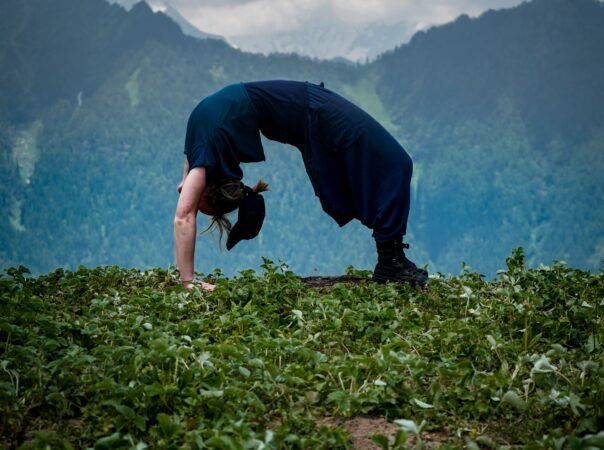Rooted in Strength : Mastering Mountain Pose for Balance, Posture and Inner Peace
Mountain Pose, known in Sanskrit as Tadasana, is often considered the foundation of all standing yoga postures. While it may appear simple at first glance, this pose is a powerful tool for developing strength, improving posture, and cultivating mindfulness. In this blog post, we’ll explore the intricacies of Mountain Pose, its benefits, and how to incorporate it into your yoga practice for maximum effect.
The Essence of Mountain Pose
Tadasana, derived from the Sanskrit words “tada” (mountain) and “asana” (pose), embodies the qualities of a mountain: strength, stability, and groundedness (Iyengar, 2015). Just as a mountain stands tall and unwavering, practitioners of Mountain Pose strive to embody these same qualities in both body and mind.
At its core, Mountain Pose is about creating a strong foundation from which all other standing poses can grow. It teaches us to distribute our weight evenly, engage our muscles correctly, and find proper alignment throughout the body. More than just a physical posture, Tadasana is an opportunity to cultivate awareness and presence in the moment (Stephens, 2010).
The Anatomy of Mountain Pose
To truly understand and benefit from Mountain Pose, it’s essential to break down its components:
- Feet and Legs: The foundation of Mountain Pose begins with the feet. Stand with your feet together or hip-width apart, depending on your preference and balance. Press all four corners of your feet into the ground, lifting the arches slightly. Engage your leg muscles, drawing energy up from your feet through your calves, knees, and thighs (Long, 2009).
- Pelvis and Core: Maintain a neutral pelvis, neither tucking nor tilting. Engage your core muscles lightly to support your lower back. This engagement helps create a sense of stability and strength in your center (Kaminoff & Matthews, 2012).
- Spine and Chest: Lengthen your spine, imagining a line of energy extending from your tailbone to the crown of your head. Allow your chest to open naturally, creating space for breath without forcing or exaggerating the movement (Coulter, 2001).
- Shoulders and Arms: Draw your shoulder blades down your back and slightly toward each other, creating a sense of openness across your collarbones. Let your arms hang naturally by your sides, with your palms facing your thighs or turned slightly forward (Iyengar, 2015).
- Head and Neck: Keep your head in a neutral position, with your chin parallel to the ground. Imagine a string gently pulling the crown of your head toward the ceiling, creating length in your neck without straining (Stephens, 2010).
The Benefits of Mountain Pose
While it may seem simple, regular practice of Mountain Pose can yield numerous benefits:
- Improved Posture: By focusing on proper alignment in Tadasana, practitioners can develop better awareness of their posture in daily life. This improved posture can help alleviate back pain and reduce the risk of musculoskeletal issues (Coulter, 2001).
- Enhanced Balance: The act of standing still and focusing on even weight distribution improves proprioception (awareness of body position) and overall balance. This can be particularly beneficial for older adults or those recovering from injuries (Tiedemann et al., 2013).
- Strengthened Core and Legs: Maintaining proper alignment in Mountain Pose requires engagement of the core and leg muscles, leading to improved strength and stability over time (Long, 2009).
- Increased Body Awareness: Practicing Tadasana encourages a deep connection between mind and body. This heightened awareness can translate to better form in other yoga poses and increased mindfulness in daily activities (Kraftsow, 2002).
- Stress Reduction: The focus required to maintain proper alignment in Mountain Pose can serve as a form of moving meditation, helping to calm the mind and reduce stress (Stephens, 2010).
- Improved Breathing: The open chest position in Tadasana allows for fuller, deeper breaths. This can lead to improved oxygen uptake and a sense of calm (Kaminoff & Matthews, 2012).
Incorporating Mountain Pose into Your Practice
While Mountain Pose is often used as a starting point for other standing poses, it can also be practiced on its own as a powerful tool for developing awareness and strength. Here are some ways to incorporate Tadasana into your yoga routine:
- Use it as a reset: Between more complex poses, return to Mountain Pose to check in with your body, realign, and refocus your mind (Iyengar, 2015).
- Practice with eyes closed: Once you’re comfortable with the basic alignment, try practicing Mountain Pose with your eyes closed. This can enhance your sense of balance and internal awareness (Stephens, 2010).
- Add arm variations: Experiment with different arm positions to challenge your balance and engage different muscle groups. Try raising your arms overhead, bringing your palms together at your heart, or clasping your hands behind your back (Long, 2009).
- Explore different surfaces: Practice Mountain Pose on various surfaces like grass, sand, or a folded blanket to challenge your balance and increase foot and ankle strength (Kaminoff & Matthews, 2012).
- Use props: Incorporate props like blocks or a wall to help you find proper alignment and deepen your understanding of the pose (Iyengar, 2015).
Common Mistakes and How to Avoid Them
Even in a seemingly simple pose like Tadasana, there are common mistakes that can limit its benefits:
- Locking the knees: Keep a micro-bend in your knees to avoid hyperextension and promote healthy joint function (Coulter, 2001).
- Clenching the buttocks: While some engagement is necessary, overly clenching the glutes can lead to misalignment in the pelvis. Focus on a neutral pelvis position instead (Long, 2009).
- Jutting the ribs forward: Avoid pushing your chest too far forward, which can strain the lower back. Instead, focus on lengthening through the spine while maintaining a natural curve (Kaminoff & Matthews, 2012).
- Tensing the shoulders: Keep your shoulders relaxed and away from your ears. Periodically check in and release any tension you may be holding in this area (Iyengar, 2015).
- Forgetting to breathe: In the concentration of maintaining alignment, it’s easy to hold your breath. Remember to maintain steady, even breaths throughout the pose (Stephens, 2010).
Mountain Pose for Mindfulness
Beyond its physical benefits, Tadasana offers a unique opportunity for mindfulness practice. As you stand in the pose, try the following:
- Body scan meditation: Starting from your feet and moving upward, mentally scan your body, noticing sensations and making small adjustments as needed (Kabat-Zinn, 2013).
- Breath awareness: Focus on the rhythm of your breath, noticing the rise and fall of your chest and the sensation of air moving through your nostrils (Kraftsow, 2002).
- Grounding visualization: Imagine roots growing from the soles of your feet deep into the earth, anchoring you and providing stability (Stephens, 2010).
- Mantra repetition: Choose a simple mantra or affirmation to repeat silently as you stand in Mountain Pose, helping to focus your mind and reinforce positive intentions (Iyengar, 2015).
Conclusion
Mountain Yoga Pose, while outwardly simple, offers a wealth of benefits for both body and mind. By practicing Tadasana regularly and with intention, you can improve your posture, strengthen your body, enhance your balance, and cultivate a deeper sense of mindfulness. Whether you’re a beginner just starting your yoga journey or an experienced practitioner looking to refine your practice, returning to the foundations of Mountain Pose can provide valuable insights and a strong base for growth.
Remember, as with any yoga pose, it’s essential to listen to your body and work within your limits. If you have any health concerns or injuries, consult with a qualified yoga instructor or healthcare professional before beginning or modifying your practice.
As you continue to explore and deepen your understanding of Mountain Pose, you may find that its principles of alignment, awareness, and presence extend far beyond your yoga mat, influencing how you carry yourself in daily life and how you face life’s challenges. Like a mountain, may you find strength, stability, and serenity in your practice and in your life.
Written by : Farokh Shabbir
References
Coulter, H. D. (2001). Anatomy of Hatha Yoga: A Manual for Students, Teachers, and Practitioners. Body and Breath.
Iyengar, B. K. S. (2015). Light on Yoga: The Bible of Modern Yoga. Schocken.
Kabat-Zinn, J. (2013). Full Catastrophe Living: Using the Wisdom of Your Body and Mind to Face Stress, Pain, and Illness. Bantam.
Kaminoff, L., & Matthews, A. (2012). Yoga Anatomy. Human Kinetics.
Kraftsow, G. (2002). Yoga for Wellness: Healing with the Timeless Teachings of Viniyoga. Penguin.
Long, R. (2009). The Key Muscles of Yoga: Scientific Keys, Volume I. Bandha Yoga Publications.
Stephens, M. (2010). Teaching Yoga: Essential Foundations and Techniques. North Atlantic Books.
Tiedemann, A., O’Rourke, S., Sesto, R., & Sherrington, C. (2013). A 12-week Iyengar yoga program improved balance and mobility in older community-dwelling people: a pilot randomized controlled trial. The Journals of Gerontology Series A: Biological Sciences and Medical Sciences, 68(9), 1068-1075.











